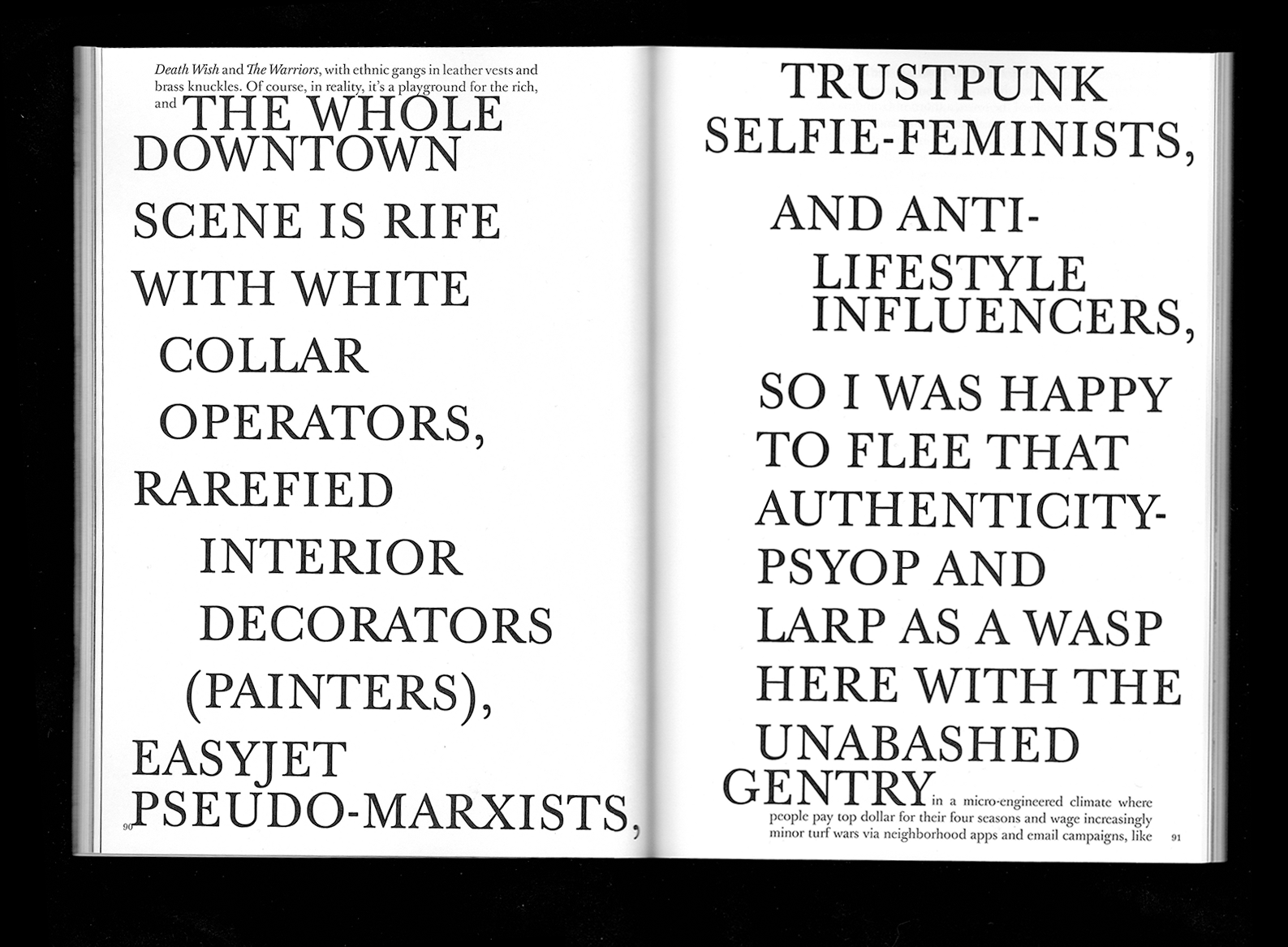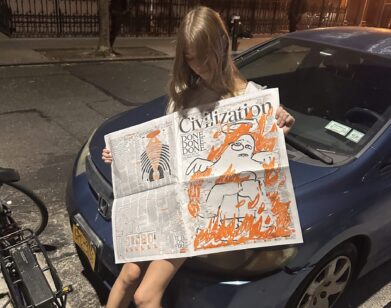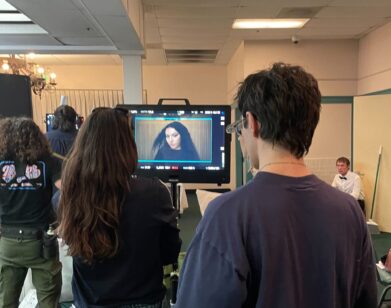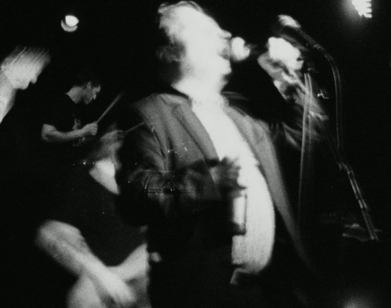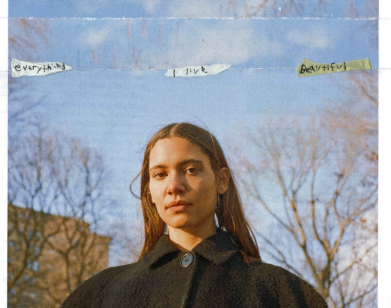ANTI
Meet Heavy Traffic, the Heavily Edited Alt-Lit Mag
Some of my favorite stories I’ve read over the past few years have been published by Patrick McGraw’s Heavy Traffic magazine. Honor Levy’s “Pillow Angels,” from the site, unfurls at a high school sleepover in Los Angeles. Here are a few lines I like: “I am staring at the clumps of Nobu and Pink Berry swirling like dervishes in the toilet. We all want to be Dachau-liberation-day-skinny for spring break on Little Saint James. We need a vacation because LA is like Narnia now.” Seth Price’s “Machine Time,” from the first print issue, follows an artist from New York visiting a mysterious trader’s tropical island compound: “Show me a newborn and I will know this lump as it was in the dim shape of nothingness, and as a middle-aged soul shipwrecked on a reef, and as a dying organism: the full person, in four dimensions, a deck of cards splayed on the baize. It’s all there, it’s all broken, and that’s the love I’m holding out for.” From the brand new issue, launched last Friday at Mulberry Street Bar in Little Italy, Andrew Norman Wilson’s “Remote Viewing” contains some wisdom passed down through time: “Grandma internalized this from an early age. She always told herself, you have to start romanticizing your life. You have to start thinking of yourself as the main character. Because if you don’t, life’s abundance will continue to pass you by. And you’ll never be able to claim as your own all the things that make life so beautiful.”
Patrick says these stories are not really short stories at all; they’re short fictions, they’re something else, they are fragments of a much longer, unfinished, heavily stylized text. Issue 2 opens with a piece by Marcus Mamourian, who played a big role in inspiring the magazine and who passed away last year. It also has new fiction by Levy, McGraw, Dean Jamieson, Fiona Alison Duncan, Saoirse Bertram, Paris Reid, Wilson, Lynne Tillman, Hedi El Kholti, Olivia Kan-Sperling, Drew Ohringer, design by Richard Turley, some advertisements, and nothing else.
———
DEAN KISSICK: What was the genesis of Heavy Traffic?
PATRICK MCGRAW: We published our first story in 2020, but I’d had the idea for Heavy Traffic for a few years before that. I had been writing for more mainstream magazines, which was pretty unsatisfying work, and I was always writing fiction on the side. But there was nowhere to publish the type of fiction that I was writing. Particularly the first story I wrote for Heavy Traffic, “Permanent Hospice.”
KISSICK: Why not?
MCGRAW: It was so mundane in a way and purely style-driven: just an 800-word piece about an old lady who lives on 58th Street. Around the same time, I was talking a lot to my friend Marcus Mamourian. He was the first person I met who felt the same way about fiction and who wrote like me. Eventually I told Marcus that I had an idea for a short fiction magazine. It really wouldn’t have started without him because he literally pushed me to do it many times.
Once the pandemic happened, we were stuck in our respective apartments and were just talking to each other every day and sending stories back and forth in a group chat that also included Honor Levy. The three of us spent the entire first couple months of the pandemic sending stories back and forth in this chat, and essentially trying to turn the chat into a story.
Julian Garcia was around that time as well, he was designing the early iteration of the magazine and the website at that time. Julian was one of my oldest friends. He’s a great designer. Cameron David Moreno was helping at the time as well.
KISSICK: Tell me about these people.
MCGRAW: Deranged. Extremely sensitive people. To write a story that’s entirely about an old lady on 58th Street, or in Marcus’s case, about some delinquent who lives in Florida, and to affect these people’s lives and style; to write an entire piece about these things you have to be very sensitive in a way.
And Honor, Honor is just a fantastic writer. When we started talking, she was still at Bennington. Now there are a lot of people who use internet speak, but her and Marcus were the only people who were using it artfully in writing at the time. Of course, all this now seems quite old hat. To describe Honor’s style, it sounds quite common now. But there wasn’t a place to publish stories like these even just a couple years ago. We texted all day and night about fucked up shit and traded stories with each other. And when I look back at the chat, there are whole stories in the chat, whole full stories that we would send each other.
KISSICK: Were you here in the city?
MCGRAW: I was stuck in Vancouver. Then I was in Long Beach, California. Honor was at her parents’ place in LA. Marcus was somewhere outside of Philadelphia. We were all so zonked out on drugs. This is the other thing. I think I was talking with Honor about this the other day, but when “Pillow Angels,” which is Honor’s—
KISSICK: It’s my favorite story of hers.
MCGRAW: It’s a fantastic piece of Honor’s, and it’s a lot of people’s favorite story. I’d been up for I think two days when we started editing it together. She’d been up for three or four days. And it was about four in the morning in May, 2020. We’d been up for days and were just writing and editing and getting stuff in shape. It was exciting.
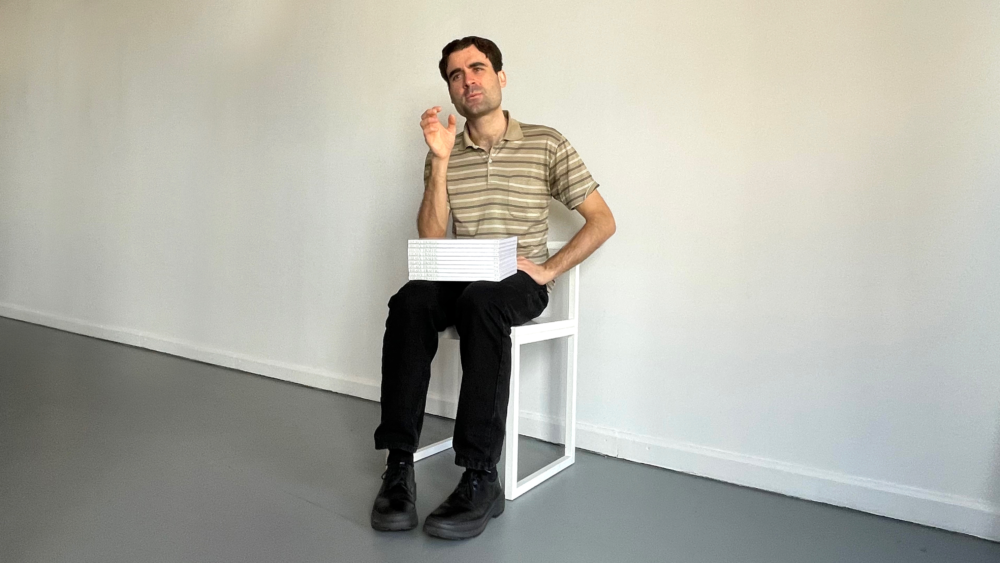
Image courtesy of Patrick McGraw.
KISSICK: The new issue opens with a story of Marcus’s. I think it’s the first fiction of his that’s been published by you.
MCGRAW: We published Marcus’s interviews with Dennis Cooper and Brad Phillips. But never fiction. After Marcus’s death, friends from all periods in his life started compiling a bunch of his work in a Dropbox folder: fiction, poetry, art, theory, radio shows. Stuff he’d produced and shared with friends from like 2015 to 2022. I hope that that other work can be shared publicly, too, some day. Olivia Kan-Sperling and another close friend spent a long time sifting through his writing and gave “Buddy Mold” to me one night at a bar. It’s a story from 2020. It really epitomizes the Heavy Traffic style. A lot of stuff even from a couple of years ago is quite cringe to read now, but when I read this piece by Marcus I thought, “This is why I started Heavy Traffic.” The piece just opens right off the bat. It’s a cold open. With any piece in Heavy Traffic, you can read a single sentence and you don’t necessarily have to know what’s happening in the piece or the arc of it, or structurally where you are, and yet you will get something from reading that sentence. Every sentence is kind of a standalone piece. That’s the style of Heavy Traffic: just this urgent, unstructured, but heavily stylized prose. What a lot of people would say is an “affected “ style of writing.
KISSICK: What do you mean by that?
MCGRAW: I’m adopting a voice to write with. But it’s often just a characterization of myself or the way I think, instead of sitting down and trying to write as earnestly in your own voice as possible. With Heavy Traffic the writing is characterized. In Marcus’s case, he’s adopting the style of this guy who lives in Florida, an idiot really. And he’s writing from the point of view of this person. So he’s embodying that person. And it’s like my first piece on the Heavy Traffic website as well. I’m this old lady who lives on 58th Street. But it’s just a version of me. And same with Marcus, he’s Buddy Mold in that story, so he’s affecting that character.
KISSICK: You’re taught to write affectlessly. That’s how literature is taught in the schools I hear. People complain about it all the time: This affectless style needs to be overcome somehow.
MCGRAW: But also when you look at a lot of autofiction, it’s supposed to be extremely affectless.
KISSICK: Yeah, it’s anti-art.
MCGRAW: Exactly.
KISSICK: Anti-imagination.
MCGRAW: Yeah.
KISSICK: Who else worked on this issue?
MCGRAW: So, Saoirse Bertram is the assistant editor. I met him in Honor’s old apartment on 17th Street too, also in the summer of 2020 with Marcus. But he started working for the magazine early last year. He’s a brilliant reader and performer. Saoirse gave one of the best readings I’ve ever seen at a Heavy Traffic reading last March.
KISSICK: And you’re working with [Interview’s Design Director] Richard Turley on this issue.
MCGRAW: Yeah. Richard is brilliant. He understood what I was saying about style immediately from the get-go. The ideas that he’s had have been the direct visual representation of this kind of immediacy and severity of the Heavy Traffic style. Which is what sets Heavy Traffic apart. Because there are some other fiction magazines at this point. There are other places of published fiction.
KISSICK: There are some others.
MCGRAW: Yes, but they are different projects. Heavy Traffic is not positive. It’s not a community project. It’s more severe, and colder. I think the fiction represents that. Richard’s design represents that well.
KISSICK: What do you mean by colder?
MCGRAW: Coldness means distance. I think with a lot of magazines, they’re trying to build a community around themselves, or they’re trying to do something that’s of the moment.
KISSICK: I think that’s what makes them good in a way.
MCGRAW: Exactly, I agree.
KISSICK: Forever Mag and The Drift, to me, are also social projects.
MCGRAW: They’re social projects. Exactly.
KISSICK: And what’s most exciting about them to me, is how good they are at doing that. At creating this community. And putting on events and getting a crowd there. It’s a very different approach.
MCGRAW: They’re very good at doing that, absolutely. And I’m really happy they’re there, of course. But Heavy Traffic has nothing to do with that at all. We’re almost an anti-community project. All I really care about is the content.
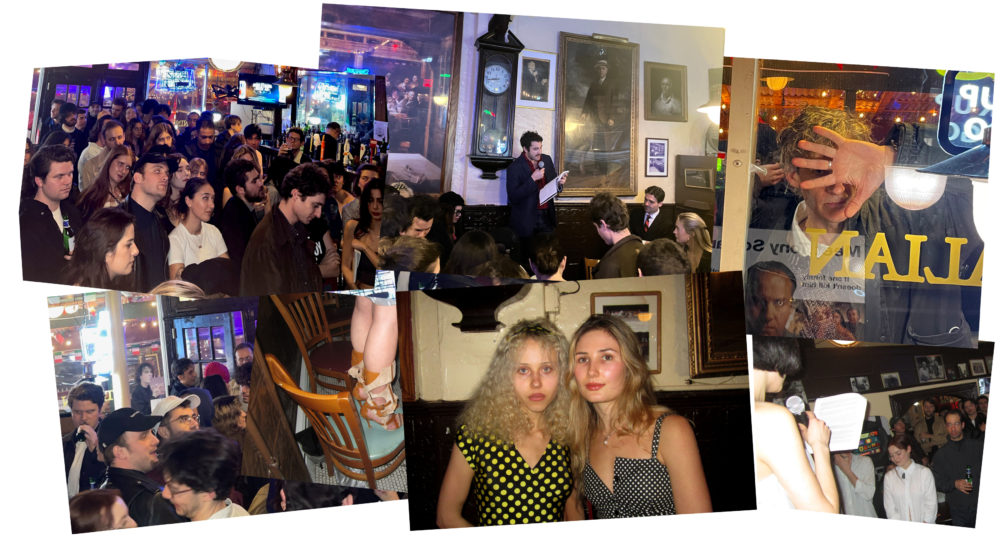
Heavy Traffic Launch at Mulberry Street Bar, Feb 10 2023
KISSICK: You have events sometimes.
MCGRAW: We have events sometimes. But with a community-based project, you’re trying to make something for the moment, of the moment. But with Heavy Traffic, really, it’s just one long piece. It’s one long project. When you look back at Heavy Traffic in five years, and there have been however many issues, it will read like one issue. It’s not supposed to be something that’s about right this moment. A Heavy Traffic piece feels like living in general. We don’t put on parties. We’re not a community beacon. But we are an imagined community. Heavy Traffic is an imagined community. You might not be at a Heavy Traffic party, because they don’t exist, but when you’re reading Heavy Traffic you’re able to enter into this Heavy Traffic universe, really.
KISSICK: Let’s talk more than the idea that’s the long piece of fiction.
MCGRAW: The long piece.
KISSICK: That’s achieved through…
MCGRAW: Heavy editing. Every piece in Heavy Traffic is heavily edited. It was hard to start Heavy Traffic because there’s no theme, there’s no prompt, there’s no structure that we go by. When I commission a writer or when a writer asks to write for Heavy Traffic, I just send them other pieces that have been published in Heavy Traffic that I think are representative of what Heavy Traffic is. But now, we’re at a good point where we’ve published enough and people are familiar enough with it, that when I commission a writer, even a very well-known writer who writes in a very different way, and they’ve read Heavy Traffic, they are able to submit to the style. They know how to write for it. We’ve developed this kind of style, a Heavy Traffic style of writing. But every piece gets edited.
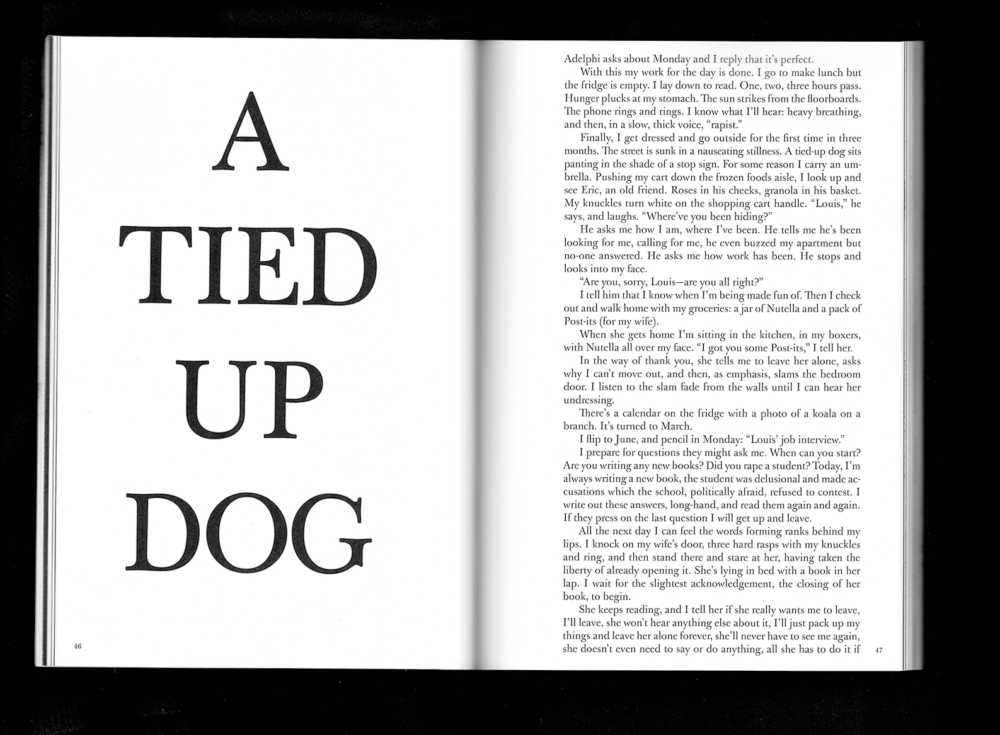
KISSICK: What’s your approach to editing?
MCGRAW: You have to adopt the writer’s voice. I think if there’s one thing I’m good at, it’s knowing—
KISSICK: You affect the writer’s affected voice.
MCGRAW: Exactly. But when I read a writer’s piece I’m able to affect their voice and know how far they would go in either direction and what’d they’d be comfortable with. So I can play with that voice to make it better. But frankly I try to make pieces less colloquial, less friendly.
KISSICK: And are you editing for clarity, for prosody, beauty, vibe, style?
MCGRAW: Style. Maintaining the style of Heavy Traffic is a goal of mine. I didn’t study writing, I studied architecture and I’ve been more in the art world than the literature world for a long time. I really like artists and architects’ writing specifically. For architects, it takes a long time before you’re actually able to build something and in the meantime they often just write. I always like that style of writing, and artists’ writing. Untrained writers. I never want to stray too far from that as an aspect of the style. I don’t want it to get too far away from the Seth Price piece in the first issue for instance. Our foot is in both worlds quite thoroughly. It’s important not to just be seen as a literary mag.
KISSICK: Heavy Traffic is essentially a magazine publishing short stories and nothing else. But in the editor’s letter for the first issue, you also said that “short stories” aren’t the right words for what you’re doing here.
MCGRAW: There are a lot of different words for it.
KISSICK: How do they differ from short stories?
MCGRAW: Well, when you don’t have a prompt, you don’t have structure, and you just have style… each piece is just a burnout. If you look at Honor’s new piece, it just explodes and fizzles out. So that’s what a short fiction is. It doesn’t really go anywhere. In L. Rust Hills’ [former fiction editor at Esquire] book about writing fiction he quotes another editor who said the ideal structure for a short story is just somebody walking down Fifth Avenue. Anything can happen while you’re walking down Fifth Avenue. You get a call from your ex-wife, you see a guy get killed, but you’re still always walking down Fifth Avenue; from 50th to 45th. There’s that kind of thing moving it through. Short fiction is always a very simple movement. It’s usually just one movement. And that’s what I like about it. In a longer story you might take a turn into the Diamond District or something. But in a short fiction, it’s just walking down Fifth Avenue.

